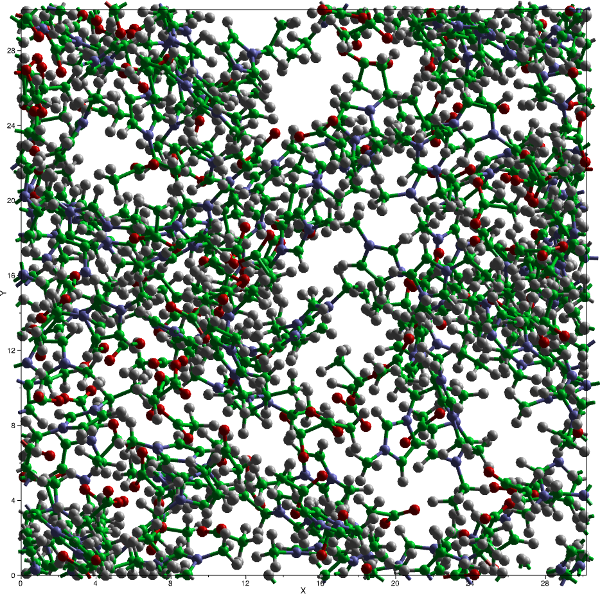Step 4 - Make the Ionic Liquid
Time to create a configuration to represent the ionic liquid.
Generate the Configuration
Configuration ⇨ Create…
Choose both species and press
Leave the configuration type as Mixture and press
Leave the box style as Fixed Geometry, Undefined Size and press
Set the Density to
0.09985and the units toatoms/A3, and the Multiplier to100. This gives us a box with side length of 29.6398 Å which is quite small for an ionic liquid, but in the interests of time we’ll leave it as that. Press to complete the wizard.
Double-click on the configuration tab’s title and change its name to
Bulk
We need to adjust our pair potential range which is currently set to 15 Å and exceeds the half-cell width:
Go to the
Forcefield tab, section
In the Pair Potentials controls, change the Range to
12.0
The final thing to do is change the temperature (our experimental data was measured at 323 K) and set a size factor for our box - since we have rings in our cation we need to apply a size factor during the initial equilibration to help prevent occurrences of interlocking rings.
Go to the
Bulk configuration tab
On the configuration viewer toolbar, click the button
Set the Temperature to
323.0
Click the button
Drag the
SizeFactor node into the Node list
Select the
SizeFactor node
Set the SizeFactor to
10.0

Initial box of 1-ethyl-3-methylimidazolium acetate
Equilibrate
Let’s now add a suitable evolution layer for the system and set things running:
Layer ⇨ Create ⇨ Evolution ⇨ Standard Molecular (MC/MD)
Now we can equilibrate our system:
Ctrl-F
Set the number of iterations to
1000and hit
You might want to track the change in energy of the system in the
tab of the


After one thousand iterations the size factor of the configuration should have returned to 1.0 (check this on the configuration tab!) and the intermolecular energy of the system should have reached a stable negative value of about –100 kJ mol-1 (for 100 ion pairs). The charged nature of the species in the present system means that reaching equilibrium can take a lot longer than for a system containing only small, neutral molecules - bear this in mind when running such systems. Also note that the total energy of the configuration remains large and positive due to the intramolecular energy contributions.

Equilibrated box of 1-ethyl-3-methylimidazolium acetate